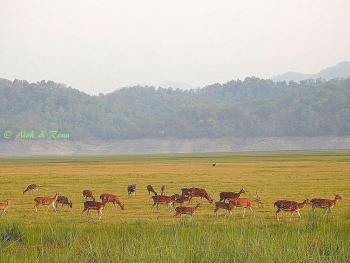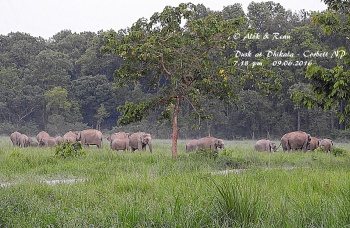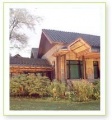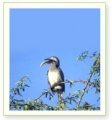| This article is incomplete. This article is missing one or more sections. You can help the BirdForum Opus by expanding it. |
Overview
This National Park, located in the Himalayan state of Uttaranchal in Northern India, is one of the best places for birdwatching and other nature based hobbies. It currently hosts almost half the number of species of birds in the Indian subcontinent - over 600 species. It is centrally located in the Kumaon Mountains in the heartland of Uttaranchal. It covers some 920.9 square km at an altitude of 600 to 1100 metres. Anyone willing to visit India should not miss this enchanting place.
Birds
Notable Species
Great Barbet, Wallcreeper and many flycatchers winter in the park.
Check-list
Birds you can see here include:
Changeable Hawkeagle, Purple Sunbird, Plum-headed Parakeet, Grey-headed Woodpecker, Jungle Babbler, Red Jungle Fowl, Yellow-footed Green Pigeon, Spotted Dove, Scarlet Minivet, Red-vented Bulbul, Red-whiskered Bulbul, Great Egret, Common Mynah, Rose-ringed Parakeet, River Lapwing, Pied Kingfisher, White-throated Kingfisher, Stork-billed Kingfisher, Black Kite, Asian Green Bee-eater, White-capped Water Redstart, Cinereous Tit, Rufous Treepie, Little Heron, Common Sandpiper, Black Drongo, Oriental Honey Buzzard, Indian Pond Heron, Blue Whistling Thrush, Crimson Sunbird, Black-hooded Oriole, Streak-throated Woodpecker, Lineated Barbet, White-browed Wagtail, Red-headed Vulture, Greater Flameback, Bonelli's Eagle, Red-billed Grey Magpie, Grey Bushchat, Streaked Laughing Thrush, Slate-headed Parakeet, Great Barbet, Mountain Hawk Eagle, Common Kestrel, Golden-fronted Leafbird, Indian White-eye, Grey Wagtail, White Wagtail, Yellow-throated Sparrow, Little Ringed Plover, White-rumped Shama, Black-rumped Flameback, Eurasian Hoopoe, Rufous-cheeked Scimitar-Babbler, Crested Serpent Eagle, Indian Peafowl, Emerald Dove, Collared Scops Owl, Oriental Pied Hornbill, Indian Grey Hornbill, Sind Sparrow(?), Himalayan Flameback, Kaleej Pheasant
Other Wildlife
To do

Photo by Alok Tewari
Shivalik Himalayas, Corbett National Park, June 2016
Site Information
Best times to visit at Corbett National Park are: winter from November to February, summer from March to June and the rainy season the rest of the year.
History and Use
It was set up in 1936 by Jim Corbett, as the first Indian National Park, basically as a safe haven and for the preservation of Indian Tigers.
Access and Facilities
- Temperature range in Corbett National Park: 4C in winter to 42C during summer.
- The park is 1143 meters above sea level
Contact Details
- Email: jimcorbettpark@gmail.com
- Phone: +91-9719251997
External Links
Jim Corbett National Park
Fact sheet for the park, with directions and best times to visit
Content and images originally posted by Arunav
Reviews
Sussex bird man's review: I visited Corbett for a 4 day stop over following business in New Delhi in March this year. I bought a package whilst in the UK, staying at the Infinity Resort near Ramnagar, the nearest city. I travelled from New Delhi to Ramnagar by sleeper train, arriving at around 05:30 in the morning. Arrival was swiftly followed by a 07:00 excursion. Each excursion was led by a local guide. In addition to the standard package I took a long day trip to Machoor in the Himalayan foothills where you rise to around 2,000m. The scenery is stunning, the people are extremely friendly and the guides that I encountered where very knowledgable. I recommend a walk around the Kosi river and the Machoor drive (about 12 hours by jeep). Species positively identified: Changeable Hawkeagle, Purple Sunbird, Plum-headed Parakeet, Grey-headed Woodpecker, Jungle Babbler, Red Jungle Fowl, Yellow-footed Green Pigeon, Spotted Dove, Scarlet Minivet, Red-vented Bulbul, Red-whiskered Bulbul, Great Egret, Common Mynah, Rose-ringed Parakeet, River lapwing, Pied Kingfisher, Whte-throated Kingfisher, Stork-billed Kingfisher, Black Kite, Asian Green Bee-eater, White-capped Water Redstart, Cinereous Tit, Rufous Treepie, Little Heron, Common Sandpiper, Black Drongo, Oriental Honey Buzzard,Indian pond Heron, Blue Whistling Thrush, Crimson Sunbird, Black-hooded Oriole, Streak-throated Woodpecker, Lineated Barbet, White-browed Wagtail, Red-headed Vulture, Greater Flameback, Bonelli's Eagle, Red-billed Grey Magpie, grey Bushchat, Streaked Laughing Thrush, Slate-headed Parakeet, Great Barbet, Mountain Hawk Eagle,Common Kestrel, Golden-fronted Leafbird, Oriental white-eye, Grey Wagtail, White Wagtail, Chestnut-shouldered Petronia, LIttle Ringed Plover, White-rumped Shama, Black-rumped Flameback, Hoopoe, Rufous-cheeked Scimitar-Babbler Crested Serpent Eagle, Indian Peafowl, Emerald Dove, Collared Scops Owl, Oriental Pied Hornbill,Grey Hornbill, Sind Sparrow(?), Himalayan Flameback and Kaleej Pheasant. Not bad for a non-twitcher!!!! Good luck to anyone who ventures there!!!!! Pros
- Ease of access
Cons
- None really







